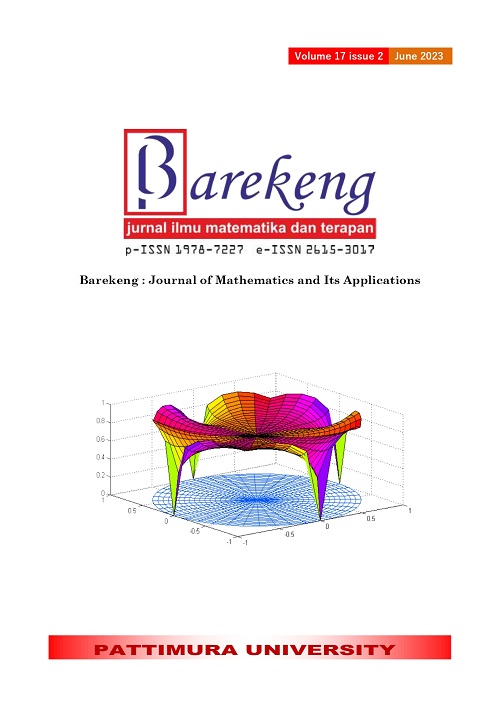CROSS PRODUCT OF IDEAL FUZZY SEMIRING
Abstract
If one of the axioms in the ring, namely the inverse axiom in the addition operation, is omitted, it will produce another algebraic structure, namely a semiring. Analogous to a ring, there are zero elements, ideal (left/right) in a semiring, and the cross product of the semiring ideal. The analog of the fuzzy semiring has zero elements, ideal (left/right), and the cross product of the semiring fuzzy ideal associated with the membership value. This paper will discuss the cross-product of two (more) fuzzy ideals from a semiring. Furthermore, the cross-product of two (more) fuzzy ideals from a semiring will always be a semiring fuzzy ideal. But the converse is not necessarily true.
Downloads
References
M. P. Grillet, “On semirings which are embeddable into a semiring with identity,” Acta Math. Acad. Sci. Hungaricae, vol. 22, no. 3, pp. 305–307, 1971, doi: 10.1007/BF01896422.
D. F. Goguadze, “About the Notion of Semiring of Sets,” Math. Notes, vol. 74, no. 3, pp. 346–351, 2003, doi: 10.1023/A:1026102701631.
Y. Katsov, “Toward Homological Characterization of Semirings: Serre’s Conjecture and Bass’s Perfectness in a Semiring Context,” Algebr. universalis, vol. 52, no. 2, pp. 197–214, 2005, doi: 10.1007/s00012-004-1866-0.
E. M. Vechtomov, A. V Mikhalev, and V. V Sidorov, “Semirings of Continuous Functions,” J. Math. Sci., vol. 237, no. 2, pp. 191–244, 2019, doi: 10.1007/s10958-019-4150-8.
Y. N. Wu, X. Z. Zhao, and M. M. Ren, “On varieties of flat nil-semirings,” Semigr. Forum, vol. 106, no. 1, pp. 271–284, 2023, doi: 10.1007/s00233-023-10337-2.
L. A. Zadeh, “Fuzzy Sets,” Inf. Control, vol. 8, no. 3, pp. 338–353, 1965, doi: https://doi.org/10.1016/S0019-9958(65)90241-X.
S. Bashir, R. Mazhar, H. Abbas, and M. Shabir, “Regular ternary semirings in terms of bipolar fuzzy ideals,” Comput. Appl. Math., vol. 39, no. 4, pp. 1–18, 2020, doi: 10.1007/s40314-020-01319-z.
S. K. Sardar, S. Goswami, and Y. B. Jun, “Role of Operator Semirings in Characterizing Γ - semirings in Terms of Fuzzy Subsets,” vol. 8658, 2019, doi: 10.1007/s12543-012-0115-z.
M. Akram and W. A. Dudek, “Intuitionistic fuzzy left k-ideals of semirings,” Soft Comput., vol. 12, no. 9, pp. 881–890, 2008, doi: 10.1007/s00500-007-0256-x.
C. B. Kim, “Isomorphism theorems and fuzzy k-ideals of k-semirings,” Fuzzy Sets Syst., vol. 112, no. 2, pp. 333–342, 2000, doi: 10.1016/S0165-0114(98)00018-9.
S. Ghosh, “Fuzzy k-ideals of semirings,” Fuzzy Sets Syst., vol. 95, no. 1, pp. 103–108, 1998, doi: https://doi.org/10.1016/S0165-0114(96)00306-5.
S. Abdurrahman, “Interior ideal fuzzy semiring,” Epsil. J. Mat. Murni Dan Terap., vol. 15, no. 2, pp. 116–123, 2021, doi: ttps://doi.org/10.20527/epsilon.v15i2.4894.
S. Abdurrahman, C. Hira, and A. Hanif Arif, “Anti subsemiring fuzzy,” Epsil. J. Mat. Murni Dan Terap., vol. 16, no. 1, pp. 83–92, 2022, doi: https://doi.org/10.20527/epsilon.v16i1.5443.
M. O. Massa’deh and A. Fellatah, “Some properties on intuitionistic Q-fuzzy k-ideals and k–Q-fuzzy ideals in Γ -semirings,” Afrika Mat., vol. 30, no. 7, pp. 1145–1152, 2019, doi: 10.1007/s13370-019-00709-9.
S. Abdurrahman, “Karakteristik subsemiring fuzzy,” J. Fourier, vol. 9, no. 1, pp. 19–23, 2020, doi: 10.14421/fourier.2020.91.19-23.
S. Abdurrahman, “Ideal Fuzzy Near-Ring,” J. Epsil., vol. 6, no. 2, pp. 13–19, 2012, [Online]. Available: http://ppjp.ulm.ac.id/index.php/epsilon/article/view/83/68.
J. Neggers, Y. B. A. E. Jun, and H. E. E. S. I. K. Kim, “On L-fuzzy ideals in semiring II,” Czechoslov. Math. J., vol. 49, no. 124, pp. 127–133, 1999.
M. Durcheva, Semirings as Building Blocks In Cryptography, 1st ed. Lady Stephenson Library, Newcastle upon Tyne, NE6 2PA, UK: Cambridge Scholars Publishing, 2020.
J. S. Golan, “Semirings,” in Semirings and Affine Equations over Them: Theory and Applications, Centre for Mathematics and Computer Science, Amsterdam, The Netherlands: Kluwer Academic Publishers, 2003, pp. 1–26.
J. N. Mordeson, “Zadeh’s influence on mathematics,” Sci. Iran., vol. 18, no. 3 D, pp. 596–601, 2011, doi: 10.1016/j.scient.2011.04.012.
J. Ahsan, J. N. Mordeson, and M. Shabir, “Fuzzy Ideals of Semirings,” in Fuzzy Semirings with Applications to Automata Theory, Berlin, Heidelberg: Springer Berlin Heidelberg, 2012, pp. 15–29.
S. Abdurrahman, “Homomorphisms and (λ, µ] – Fuzzy subgroup,” AIP Conf. Proc., vol. 2577, no. 1, p. 20001, Jul. 2022, doi: 10.1063/5.0096015.
S. Abdurrahman, “ω – fuzzy subsemiring.pdf,” J. Mat. Sains, dan Teknol., vol. 21, no. 1, pp. 1–10, 2020, doi: https://doi.org/10.33830/jmst.v21i1.673.2020.
S. Abdurrahman, “Interior subgrup ω-fuzzy,” Fibonacci J. Pendidik. Mat. dan Mat., vol. 6, no. 2, pp. 91–98, 2020, doi: https://doi.org/10.24853/fbc.6.2.91-98.
S. Abdurrahman, “Produk Kartesius dari Ideal Fuzzy Near-ring,” in Seminar Nasional Matematika dan Pendidikan Matematika UNY, 2015, pp. 479–482, [Online]. Available: http://eprints.unlam.ac.id/545/1/Produk Kartesius dari Ideal Fuzzy Near-ring_Prosiding SEMNAS UNY 14 Nov 2015.pdf.
S. Abdurrahman, “Produk Kartesius Konplemen Ideal Fuzzy,” in Seminar Nasional Pendidikan Matematika Unissula 2016, 2016, pp. 305–308, [Online]. Available: http://fkip.unissula.ac.id/download/prosiding_seminar_matematika_2016.pdf.
J. N. Mordeson, K. R. Bhutani, and A. Rosenfeld, “Fuzzy Subsets and Fuzzy Subgroups BT - Fuzzy Group Theory,” J. N. Mordeson, K. R. Bhutani, and A. Rosenfeld, Eds. Berlin, Heidelberg: Springer Berlin Heidelberg, 2005, pp. 1–39.
Copyright (c) 2023 Saman Abdurrahman

This work is licensed under a Creative Commons Attribution-ShareAlike 4.0 International License.
Authors who publish with this Journal agree to the following terms:
- Author retain copyright and grant the journal right of first publication with the work simultaneously licensed under a creative commons attribution license that allow others to share the work within an acknowledgement of the work’s authorship and initial publication of this journal.
- Authors are able to enter into separate, additional contractual arrangement for the non-exclusive distribution of the journal’s published version of the work (e.g. acknowledgement of its initial publication in this journal).
- Authors are permitted and encouraged to post their work online (e.g. in institutional repositories or on their websites) prior to and during the submission process, as it can lead to productive exchanges, as well as earlier and greater citation of published works.






1.gif)



